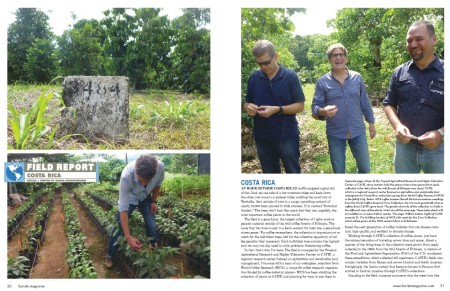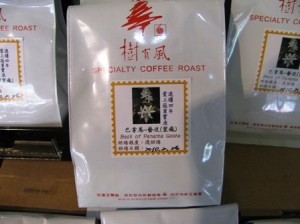- Opportunities and Threats to Harmonisation of Plant Breeders’ Rights in Africa: ARIPO and SADC. While the intention of ARIPO and SADC is to create a single internal market for protected varieties in Africa, “the end result may look quite differently.”
- Evaluation of Resistance to Ralstonia solanacearum in Tomato Genetic Resources at Seedling Stage. Out of 285 varieties from 21 countries in the Korean genebank, 4 may be resistant to bacterial wilt.
- Following the Open-Source Trail Outside the Digital World: The Case of Open-Source Seeds. “…by not rejecting the idea of property, including intellectual property, but rather attempting to manage it differently, it creates its own enclosures.”
- Grain protein concentration and harvestable protein under future climate conditions. A study of 108 spring barley accessions. Higher CO2 and temperatures lead to higher protein concentrations but lower yields, so lower harvestable protein. The good news is that there’s variation in the response of varieties.
- How can we harness quantitative genetic variation in crop root systems for agricultural improvement? Apparently we still don’t have a mechanistic understanding of root growth, and we’ll need it if we’re going to improve function.
- Bambara Groundnut for Food Security in the Changing African Climate. It’s nutritious, it’s drought tolerant, and it can be intercropped. What’s not to like?
- Neutral and functional marker based genetic diversity in kodo millet (Paspalum scrobiculatum L.). Indian material falls into 4 groups, with Bihar being very diverse. African genepool and wild species should be useful in broadening base in India.
- Origin, Dispersal, and Current Global Distribution of Cacao Genetic Diversity. We’ve come to the limit of the usefulness of the Pound Collection.
- Exploring the role of local heirloom germplasm in expanding western Washington dry bean production. 24 bean varieties have been grown in the area for 20–130 years, representing a useful starting point for participatory plant breeding.
- Growing Cassava (Manihot esculenta) in Mato Grosso, Brazil: Genetic Diversity Conservation in Small–Scale Agriculture. Lots of diversity within communities, and differences among communities. Varieties with same name not necessarily genetically similar.
- Establishment of an in vitro propagation and transformation system of Balanites aegyptiaca. So?
- Mapping cropland-use intensity across Europe using MODIS NDVI time series. Four indicators show highest cropping intensity in Germany, Poland, and the eastern European Black Earth regions, and lowest in eastern Europe outside the Black Earth region. Interesting to mash this up with agricultural biodiversity? Like earthworms?
Coffee at CATIE
In her new piece in Barista, Hanna Neuschwander really makes up for not mentioning CATIE’s genebank by name in her Coffee in the New Millennium. I take it all back.

Nibbles: Cover crops, Viet coconut, Water maps, Mao’s mango, Tudor bread, Belgian gardening, IRRI fingerprints, Stay green barley, Miniature donkey
- Uncovering cover crops, the NY Times way.
- Uncovering coconut cultivation in Vietnam, the Roland Bourdeix way.
- Where to expect water shortages, and irrigation. Crying for a mashup.
- When a mango is not just a mango.
- Bread, and much else, according to the Tudors.
- A Belgian plantsman is revolutionizing gardening. No, really.
- How genomics will revolutionize rice breeding. No, really.
- How to get deeper barley roots for drought tolerance? Look to sorghum.
- And today’s miniature livestock is…a donkey.
The hipster future of coffee starts with a genebank
I started a post a few days ago with a quote suggesting that all that commercial farmers are interested in is yield. So let’s balance that today with this:
Geisha in undoubtedly a luxury, but in one important way, it deserves the hype. It is the first coffee to be grown commercially just because it tastes good.
 We blogged about the journey of the remarkable coffee landrace called Geisha (or Gesha) a few years ago: from Ethiopia’s forests to the CATIE genebank in Costa Rica to the Peterson family farm in Panama to all over the world, or, more specifically, a hipster coffee shop in Taiwan. But Hanna Neuschwander‘s Coffee in the New Millennium tells the story at much greater length, not to mention with much greater skill. For example, I wish I had thought to describe hillside coffee plantations, with their neat, undulating rows of bushes, as “living corduroy.”
We blogged about the journey of the remarkable coffee landrace called Geisha (or Gesha) a few years ago: from Ethiopia’s forests to the CATIE genebank in Costa Rica to the Peterson family farm in Panama to all over the world, or, more specifically, a hipster coffee shop in Taiwan. But Hanna Neuschwander‘s Coffee in the New Millennium tells the story at much greater length, not to mention with much greater skill. For example, I wish I had thought to describe hillside coffee plantations, with their neat, undulating rows of bushes, as “living corduroy.”
The piece ends with a neat juxtaposition between World Coffee Research’s monumental International Multi-location Variety Trials and the more geographically focussed, but no less ambitious, in its own way, effort by the Peterson family. They’re looking for a new Geisha among hundreds of other Ethiopian landraces they are now testing on their Panamanian farm. I only have one bone to pick with Ms Neuschwander: why not fully acknowledge the role of the genebank at CATIE in all this, rather than just referring, anonymously, to “a research facility in Costa Rica”?
Nibbles: Poleward migration, Pulse infographic, Vodka, Ancient horse DNA, Old fish, Certified cacao, On farm book, Coarse millets, Banana diversity, Pearl millet demo
- Species flying poleward.
- FAO unveils pulse infographic. No word on whether any are harvestable by machine.
- Potato farmer adds value the old-fashioned way.
- Talking of old, here’s a really old horse.
- And the oldest evidence of fermentation for food preservation. But you’ll need a strong stomach.
- KitKat is certified crap.
- How (and Why) Farmers Maintain Crop Diversity: The Book. Some reviews.
- And here’s a specific example from India.
- And here, courtesy of Bioversity’s Ann Tutwiler, is why farmers need some help sometimes.
- Oh and here’s another one. People visit ICRISAT genebank in Niger, see stuff they like.